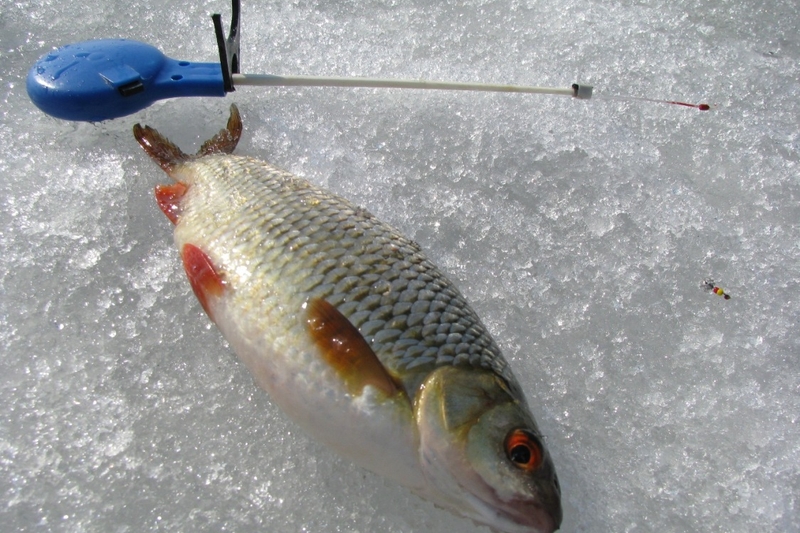As fishing in the wiring for bream turned into a hunt
 It was in July. My friend and I decided to go to the river for bream. We got up early, about three o’clock, took the boat and went fishing. Since they were going to catch on the stream, they gathered the floor of a bucket of chernozem (so that the bait was washed out longer). As bait, we used a makuha, boiled peas and barley. They were going to catch on pearl barley, moldy worm, worm and protein honey mastyrka. We went out into the water in the dark, became about five meters upstream from the supposed pit, put on a dozen medium-sized balls from bait and threw them so that, on the stream created, the float floated as accurately as possible. They laid out their six-meter carbon fiber rods (you need to enjoy fishing, not to think about when you can put the rod and rest), but they didn’t catch it right away. As a rule, right after bait, usually small fish fits – roach, buster, bleak, etc.
It was in July. My friend and I decided to go to the river for bream. We got up early, about three o’clock, took the boat and went fishing. Since they were going to catch on the stream, they gathered the floor of a bucket of chernozem (so that the bait was washed out longer). As bait, we used a makuha, boiled peas and barley. They were going to catch on pearl barley, moldy worm, worm and protein honey mastyrka. We went out into the water in the dark, became about five meters upstream from the supposed pit, put on a dozen medium-sized balls from bait and threw them so that, on the stream created, the float floated as accurately as possible. They laid out their six-meter carbon fiber rods (you need to enjoy fishing, not to think about when you can put the rod and rest), but they didn’t catch it right away. As a rule, right after bait, usually small fish fits – roach, buster, bleak, etc.
Comfortably seated in two local boat, we decided to drink coffee before fishing. In short, ten minutes later, after feeding, we began to hunt for bream.
At first, as expected, came across mostly roach and white bream. It was almost five o’clock on the clock, but there was no bream bite. Somewhere at the beginning of the sixth, the biting abruptly stopped. Several postings in a row float did not even budge. We immediately understood – bream came up.
Less than ten minutes, as my float slightly rose and walked to the side. Cutting … and in the hand already felt the prey. The first is. Fighting about five minutes with a very strong fish, I gently took it in the landing net. But it was not a large copy, weighing about a kilogram. But I wanted something more …
After the first bream was caught, (by the way, the whole bream took on barley) the biting of small fish again resumed. A flock of more serious prey, apparently moved away. But it did not last long. As at the last break, the bite of fines abruptly stopped and over the next two or three minutes we and a friend, almost simultaneously, spotted one good bream. In order not to interfere with each other and not to confuse the tackle, we parted our prey on the sides – comrade took the fish at the stern, and I from the bow. By the way, it should be noted by beginning fishermen, because, personally, I had to see pretty “funny” cases of the diving out of large fish.
In general, our fishing continued. Poklyovki large bream followed necessarily after ten – fifteen minute pauses and cool “trivia”. And it lasted about ten o’clock in the morning. Until that time, we, for two, with a friend, caught a dozen and a half solid and simply large fishes. And then, as the fishermen say, how to chop off. The trifle took constantly, and the bream was no more.
We already wanted to go home, when suddenly, on my knockdown, I felt very stubborn resistance in my hand. I just could not tear the fish from the bottom. At first, there was a feeling that I was hooked, but then … I was holding a thicker weighing about one hundred grams in my hands. She was dead and “chewed.” Literally about five minutes later, the same story repeated. And again, “chewed” gustera. A predator “entered” the pit. You had to think of something to try to catch him. And, since, I managed to feel that the predator, still quite a decent size, needed the appropriate tackle. It’s good that I’m always used to taking spinning with me. It was not difficult for me to decompose it very quickly. And now, after a few moments, I made the first cast on a wobbler, very much like a buster. But, to my surprise, there was not even the slightest hint of the presence of a large predator. What to do?
Comrade prompted me to exit. He proposed to remake spinning on livejack. Moreover, we have enough live bait.
So I did. He made a loop with two tees at the end of the wicker, stuck a small live bait into this loop and tightened it a little so that the tees were on the sides of the fish. The same wobbler, only natural. Twenty centimeters above the base of the loop, I put a thirty-gram sliding load.
Everything was ready for a “fight”. Zhivets sank to the bottom, about seven meters downstream. I relaxed the clutch on the coil and we began to wait for a bite. Comrade, as before, continued to catch the bait, but there was practically no bite.
It was not long to wait. The clutch worked so that if I did not hold the spinning in my hand, it would have been thrown overboard. Cutting and … I, to put it mildly, came to light bewilderment. On the other end of the wicker, there was clearly something.
very large and very strong. I could not lift a fish a centimeter, but I felt that it was still a fish.
We were standing on two anchors, but this did not stop the prey – it pulled us downstream, as if there were no anchors at all … My friend, in a hurry, rolled up his rod, raised both anchors and sat on the oars. It was not possible to swim back, but on the spot we still stalled.
Fortunately, the landing net was not small. A few moments later I started in him a huge … pike perch. He was absolutely powerless. Weighing it on the shore, my friend and I were taken aback …





